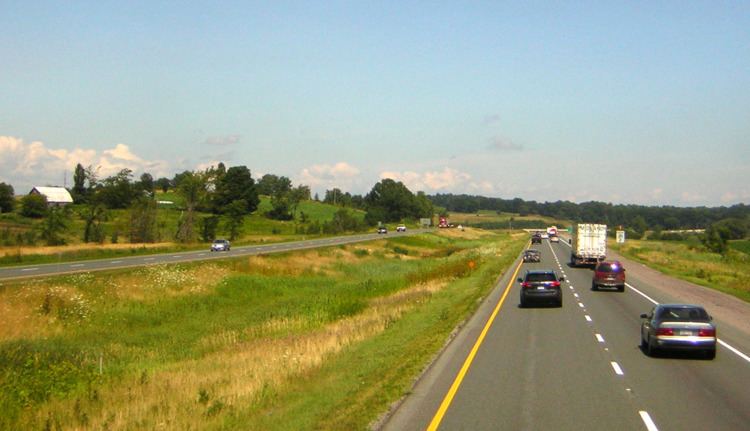 | ||
The 1999 Highway 401 crash on September 3, was a multiple-vehicle collision that resulted from dense fog conditions on a section of Highway 401 between Windsor and Tilbury. There were 87 vehicles involved in the pile-up in both directions of the divided freeway. Eight people were killed in the crash and 45 more were injured.
Contents
The crash is considered one of the worst in Canadian history, and led to significant improvements to the freeway between Windsor and Chatham.
Background
The section of Highway 401 between Windsor and London was constructed in stages in the 1950s and 1960s. It was an asphalt-paved expressway carrying two lanes of traffic in each direction, with the two carriageways separated by a grass median (which was particularly narrow between Windsor and Tilbury, as that section was the first built, in 1955), and soft gravel shoulders which had been blamed for frequent vehicle rollovers. Although parts of the freeway had been constructed with several deliberate curves to reduce driver inattention, a 32-kilometre (20 mi) stretch west of Tilbury was built following straight concession lines to minimize damage to the surrounding agricultural areas. The straight road and flat, agricultural landscape were said to cause driver fatigue and contributed to numerous collisions and pile-ups in the 1990s, earning the stretch of road the nickname Carnage Alley.
Days before the crash in 1999, Ontario Minister of Transportation, David Turnbull, had travelled the portion of freeway and called it "pleasant to drive".
Crash
On the morning of Friday, September 3, 1999, a malfunction at the Windsor Airport Observation Station failed to detect foggy conditions, and no fog warnings were issued. The malfunction was not discovered until later. Around 8:00 am near Manning Road, a tractor-trailer entered a very dense fog patch and slowed suddenly, causing a following tractor-trailer to jack-knife. Reports indicated that the fog reduced visibility to less than 1 metre (3.3 ft). Unable to see the obstruction, vehicles continued driving into the dense fog and colliding with crashed vehicles for several minutes. Although no vehicles crossed the median, there were collisions in both directions. 87 vehicles were involved, many burnt and destroyed.
Many people were injured in their vehicles or struck as they attempted to flee the pile-up. Seven people died at the scene and one more died later in hospital; 45 people were injured.
In an area dubbed the "hot zone", several vehicles were fused together, and the highway had to be repaved before reopening to traffic.
Safety improvements
A coroner's inquest into the crash led to 25 recommendations for safety improvements to the freeway. These included increasing traffic enforcement and reintroducing photo radar, as well as a review of safety standards for highway construction based on current data.
Public outrage from the crash led Turnbull to announce a plan for safer roads, including improvements to the stretch of freeway west of London. In 2004, a $322 million plan of road improvements began east of Windsor, which included fully paved shoulders and a concrete median barrier, both with rumble strips, and reflective markers in curved sections. Construction on the improvements in Carnage Alley was completed in 2010.
As of 2016, no significant highway improvements have been made to the stretch of road between Tilbury and London, due to its rural nature and long distance.
